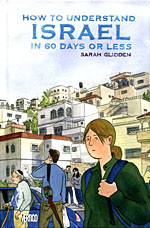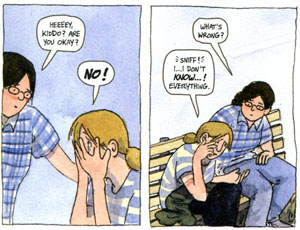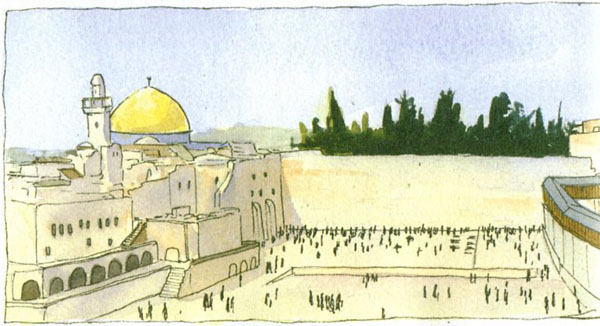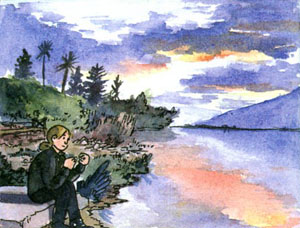 By Sarah Glidden
By Sarah Glidden
208 pages, color
Published by Vertigo/DC Comics
It’s hard (although not impossible) to find someone who doesn’t have a strong opinion on Israel and Palestine. Sarah Glidden is no exception to that rule, so when she got the chance to go on a Birthright tour of the country, she was skeptical even as she signed up for the experience. Her opinions of Israel and Zionism were well constructed by this point in her life, and she figured nothing that she saw or experienced in Israel could change her mind. What she found? Well, it was meaty enough to result in her graphic novel How to Understand Israel in 60 Days or Less.
 I first encountered Glidden’s How to Understand Israel in 60 Days or Less a few years ago, in its original black-and-white, chapter-by-chapter mini-comic format. Or rather, I encountered the first few chapters; before Glidden had finished serializing the book in that format, the book was picked up by Vertigo and that meant waiting for the completed work. Reading the finished work, though, I’ve shifted from merely enjoying Glidden’s story to becoming enthralled. Maybe it’s because in the earliest chapters, Glidden is on the offense more times than you can count. She doesn’t try to hide the fact that she isn’t happy with Israel’s treatment of the Palestinians, and her fears that she’s going to be exposed to massive amounts of propaganda while on her tour. And in those early chapters, she’s at her most rigid; constantly questioning their tour guide Gil (who is remarkably patient, although it’s no doubt neither the first nor last time he’s gone through such a situation), and muttering asides to her friend Melissa. While I wouldn’t go so far as to say that Glidden portrays herself as unlikable, it is true that Glidden comes across as someone who is finding it exceedingly difficult to do more than pay lip service to what she’s hearing.
I first encountered Glidden’s How to Understand Israel in 60 Days or Less a few years ago, in its original black-and-white, chapter-by-chapter mini-comic format. Or rather, I encountered the first few chapters; before Glidden had finished serializing the book in that format, the book was picked up by Vertigo and that meant waiting for the completed work. Reading the finished work, though, I’ve shifted from merely enjoying Glidden’s story to becoming enthralled. Maybe it’s because in the earliest chapters, Glidden is on the offense more times than you can count. She doesn’t try to hide the fact that she isn’t happy with Israel’s treatment of the Palestinians, and her fears that she’s going to be exposed to massive amounts of propaganda while on her tour. And in those early chapters, she’s at her most rigid; constantly questioning their tour guide Gil (who is remarkably patient, although it’s no doubt neither the first nor last time he’s gone through such a situation), and muttering asides to her friend Melissa. While I wouldn’t go so far as to say that Glidden portrays herself as unlikable, it is true that Glidden comes across as someone who is finding it exceedingly difficult to do more than pay lip service to what she’s hearing.
But of course, that’s one of the central threads running through How to Understand Israel in 60 Days or Less. Glidden several times confides that both she and her boyfriend are afraid that she’ll come back with a completely different viewpoint on Israel, and that she in essence will be brainwashed by her trip to the Middle East. It’s an understandable fear; the Birthright trips are designed by their very nature to present the best side of Israel for the young Jewish people from around the world getting to see the country for the first time. You know what you’re in for the second you sign up for the trip. And of course, like any potentially emotional experience, it’s one thing to make a decision from afar, another to be dropped right into the center of the country. As Glidden treads cautiously through her tour of the country, it’s interesting to see her reactions and her internal debates on what she’s viewing.

One of the many things I found fascinating about How to Understand Israel in 60 Days or Less was that part of the tour’s attempt to put a shine on everything, the areas visited included the Golan Heights (land captured from Syria during the Six-Day War in 1967), and the Negev Desert (formerly occupied primarily by Bedouin tribes). It’s in visiting these locations that Glidden is given some of her more difficult moments to digest; even as one side is presented firmly to her and her fellow travelers, debates roar through her head, filling in the opposing viewpoints. It was the Negev Desert area that struck me the most, though; perhaps because (unlike the Golan Heights, the West Bank, or the Gaza Strip) it’s not an area I knew much about. Glidden’s comparison to it as being a missing section of Epcot in Walt Disney World sounds funny at first, but it’s Glidden’s thoughts about the people that live there and what their lives are like that quickly turns it into a sobering story. It’s one of the strongest pieces of storytelling in all of How to Understand Israel in 60 Days or Less, and I think the chapter that will stick with me the most.
I greatly appreciated that in How to Understand Israel in 60 Days or Less, Glidden always makes clear (without over-emphasizing) that her opinions are her own, and that she’s not necessarily right or wrong. She shows us portions of self-doubt throughout the book, and times when she fails to mesh with the people around her. While it’s never self-deprecating, it keeps her somewhat humble, and more importantly human rather than someone there to lecture us. She shows us her missteps, her fears, and calls herself out on decisions that don’t necessarily match with what she’s felt earlier. How to Understand Israel in 60 Days or Less was clearly a learning experience for Glidden, and I appreciate that she doesn’t brush over that hurriedly.
 The art in How to Understand Israel in 60 Days or Less is especially interesting if you ever saw the mini-comics, which were attractive black and white line drawings. For the graphic novel, Glidden’s gone in with watercolors, and the end result is startling. While I liked those early incarnations of the comic, now that I’ve seen her working in full color I must admit I would be sad to see her not do so in the future. Glidden’s colors give her art an added depth, with the yellows and blues and greens blending together in a way that feels naturalistic and easy on the eyes. Looking at the end of chapter two, where the sun rises over the Sea of Galilee, it’s now hard to even remember what it looked like before. Just gorgeous.
The art in How to Understand Israel in 60 Days or Less is especially interesting if you ever saw the mini-comics, which were attractive black and white line drawings. For the graphic novel, Glidden’s gone in with watercolors, and the end result is startling. While I liked those early incarnations of the comic, now that I’ve seen her working in full color I must admit I would be sad to see her not do so in the future. Glidden’s colors give her art an added depth, with the yellows and blues and greens blending together in a way that feels naturalistic and easy on the eyes. Looking at the end of chapter two, where the sun rises over the Sea of Galilee, it’s now hard to even remember what it looked like before. Just gorgeous.
Of course there’s more to the art in How to Understand Israel in 60 Days or Less than just Glidden’s watercolors. Her characters are at a glance simple sketches, but the more you read the book, the more expressive you realize they are. You can see Melissa’s frustration over Glidden repeatedly mentioning that it’s Melissa’s first trip abroad, or the confusion on Glidden’s face when everything comes emotionally crashing down around her. Glidden has some fun flights of fancy with her art, too; the courtroom scenes set inside Glidden’s head in particular stick out as an entertaining way to illustrate her mental arguments, for example, and Glidden climbing down a ladder as the ancient structure of Tel Aviv’s many layers is equally fun. And of course, while I can’t say I’ve been to Israel myself, based on photos I’ve seen of the area, Glidden does a good job of bringing its many different environments to life.
Even if viewed solely as a travel diary, excluding the discussion of the political scene that exists there (admittedly not an easy thing to do), How to Understand Israel in 60 Days or Less is surprisingly thorough. With stops on the tour itself including the Golan Heights, the Kinneret, Tel Aviv, the Negev Desert, Masada, the Dead Sea, and Jerusalem, there’s a lot to take in. It’s Glidden’s self-journey, though, that ends up being the centerpiece. Even if you don’t view Israel any differently upon reading How to Understand Israel in 60 Days or Less, Glidden certainly leaves with a slightly different viewpoint than her arrival. Watching her reach that point is engrossing from start to finish, and I’m pleased to have been allowed to take that journey with her. I may never travel to Israel myself, but reading this book made me feel for a brief instantly like I got to do so.
Purchase Links: Amazon.com | Powell’s Books
